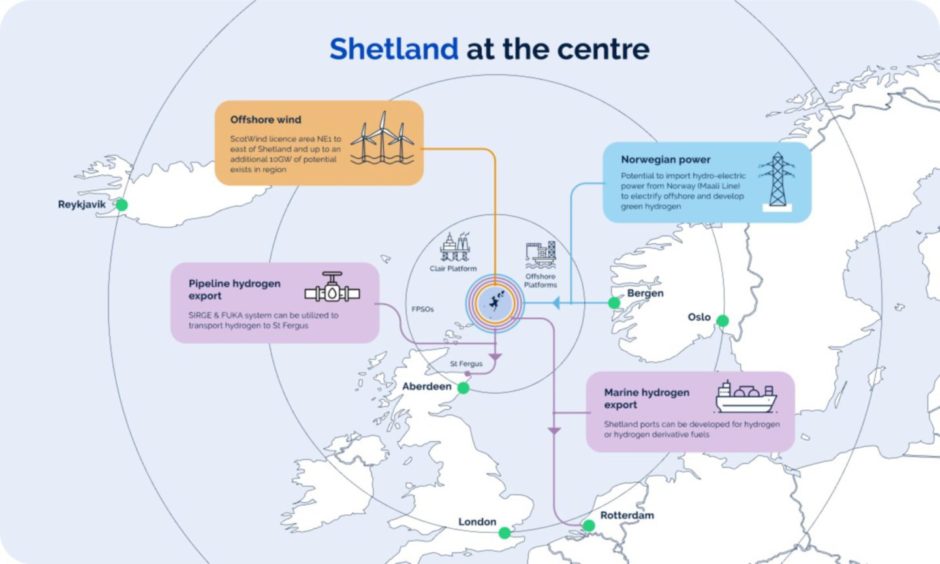
Developing clean energy technologies and bringing them to market in Shetland is the focus of a new project recently funded by the Scottish Government and led by the Net Zero Technology Centre (NZTC)
The project, known as Energy Hub, aims to offer a major step forward to a net-zero future while transforming how the energy system works.
The first phase of Energy Hub which is “at the heart of delivering the energy integration ambition” is already under way.
The concept of energy hubs is that they will produce clean energy from a combination of renewable sources such as wind, tidal and hydrogen, as well as capturing CO2 emissions through carbon capture and storage (CCS).
The hub seeks to build out offshore wind and hydrogen production technologies around Shetland, while also decarbonising oil production by providing green electricity to offshore platforms, widely referred to as “electrification” within the sector.
NZTC, alongside a range of stakeholders, including Shetland Islands Council, is already involved in the Shetland-based Orion (Opportunity, Renewables, Integration, Offshore Networks) scheme.
The Energy Hub project, which takes in Orion, recently received £2.8 million of funding from the Scottish Government to be matched by industry bringing the total to £5.6m.
Martyn Tulloch, NZTC head of energy system integration, is hoping to get as many companies as possible on board.
The first phase, which is expected to take 12 months, is now under way with a three-month consortium-forming period where they will talk to existing partners that have expressed an interest in the Energy Hub and also look at building links with other people and companies who may want to come on board.
That’s before moving on to phase two which was described by Mr Tulloch as the “real meat on the bones”.
Mr Tulloch said: “We are focusing very much on the new-technology aspects.
“There’s huge potential across Scotland. Orion is one of the leading projects and one we’ve had the closest links with over the past year and a half.
“But we are also working with other partners and looking at pulling in technology and developing their own technology, to reduce the cost of hydrogen production.
“It’s such a broad topic and £5.6m is great but it’s just a start.
“What we want to do during phase one is to have a long list of projects that we can invest in come phase two, as well as to look to alternative sources of funding.
“The Scottish Government and UK Government have both got hydrogen demonstration funding pots coming up and we want projects we can take to those.”
Cost is a significant barrier to the development of green hydrogen, which involves producing the chemical element with renewable energy. Technology development, such as the system that uses electricity to break water into hydrogen and the removal of salt from seawater, will be key.
Mr Tulloch said: “In hydrogen production quite often people focus on the electrolyser which is a central piece of equipment and we will be looking at reducing the cost of electrolysis via this project.
“But there’s also a whole host of other technologies that contribute to an energy hub.
Everything from offshore wind where you really need to have a low-cost source of green electricity to be able to produce hydrogen economically. So we need to reduce the cost of offshore wind.
“But once you get that wind back to the beach there are a lot of other processes. You’ve got to desalinate water if you are using sea water. You’ve got to be able to compress the hydrogen and store it and transport it to market.”
He added: “The scale of the opportunity is so big. Beyond phase one and two we want to see three and four where we actually commercialise these technologies.
“Because there’s so many technologies involved in an energy hub, we will invest in the highest potentials of them but then we will be looking for funding for some of the other technologies that we maybe couldn’t fund in this programme.”
Mr Tulloch said: “There’s opportunity all across Scotland and a real opportunity for the supply chain to try and capture some of the manufacturing potential here.
“These are all new technologies. There’s no established manufacturing base anywhere.
If you look at the number of electrolysers that have been manufactured it’s certainly less than one gigawatt, probably less than 100 megawatt.
“We are talking about multi-gigawatt projects that are going to require the establishment of a whole new manufacturing supply chain. And we are looking at alternative approaches to established technologies.
“We are really keen to hear from people who feel they can contribute and companies who would like to be part of this,” added Mr Tulloch.
“Although we do have strong links with our core group of people, we have an open-door policy to form as strong a consortium as possible.”
Recommended for you
